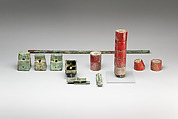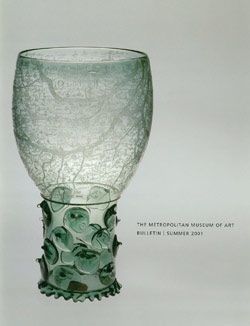Inlays and Shrine Elements
Late Period–Ptolemaic Period
In temples, statuettes of Egyptian gods were housed in small shrines, from which they emerged for rituals. Gods also had processional barks that carried shrines in which the god remained concealed during processions within and outside the temple. Wood shrines densely inlaid with figural, hieroglyphic, and decorative glass elements are attested from the late sixth century B.C. onward. Inlay elements might be placed in separate cells or be contiguously adhered on a common background. Most such shrines are, however, only known from the jumbled masses of elements preserved in temple deposits after the shrine(s) in the deposit had decayed.
This imagined scene draws from a large group of fine, monochromatic and mosaic glass inlays that were purchased together. From the same aggregation come column drums, bronze bolts appropriately in the form of a "door bolt" and "union" hieroglyphs, a square bronze rod, and four bronze attachments. The lot also included bits of gilded plaster.
For more information, see the Curatorial Interpretation below.
Link to a blog about Ptolemaic Art at The Met
Nile and Newcomers: A Fresh Installation of Egyptian Ptolemaic Art
This image cannot be enlarged, viewed at full screen, or downloaded.
This artwork is meant to be viewed from right to left. Scroll left to view more.







